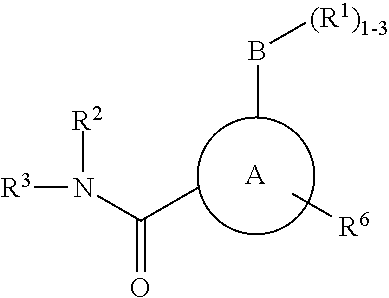P2x3 receptor antagonists for treatment of pain
a p2x3 receptor and antagonist technology, applied in the field of compounds, can solve the problems of complex utility of purinergic ligands available to evaluate the role of individual p2 receptor subtypes in mammalian physiology, intense pain, and pronounced increase in sensory nerve discharg
- Summary
- Abstract
- Description
- Claims
- Application Information
AI Technical Summary
Benefits of technology
Problems solved by technology
Method used
Image
Examples
example 1.2
[0136]
1-Methyl-3-phenyl-N-{(1R)-1-[6-(trifluoromethyl)pyridin-3-yl]ethyl}-1H-thieno[2,3-c]pyrazole-5-carboxamide
[0137]To a solution of 1-methyl-3-phenyl-1H-thieno[2,3-c]pyrazole-5-carboxylic acid (25.0 mg, 0.10 mmol), (1R)-1-[6-(trifluoromethyl)pyridin-3-yl]ethanamine (22.1 mg, 0.12 mmol), 1-(3-dimethylaminopropyl)-3-ethylcarbodiimide hydrochloride (32.5 mg, 0.17 mmol), 1-hydroxy-7-azabenzotriazole (6.6 mg, 48.0 μmol) in N,N-dimethylformamide (1 mL) was added triethylamine (54.0 μL, 0.39 mmol). The mixture was allowed to stir at 50° C. After 18 h, the mixture was cooled to ambient temperature and water (100 μL) and trifluoroacetic acid (100 μL) were added. Purification by reverse phase HPLC (C-18, 95% water / acetonitrile→5% water / acetonitrile with 0.1% trifluoroacetic acid) gave the trifluoroacetate salt of the title compound (38 mg): HRMS [M+1] found=431.1166. 1H NMR (500 MHz, DMSO-d6): δ 9.07 (1H, d, J=7.27 Hz), 8.83 (1H, s), 8.37 (1H, s), 8.09 (1H, d, J=8.25 Hz), 7.95-7.89 (3H, m)...
example 1.49
[0138]
3-(2,4-Difluorophenyl)-1-(2-hydroxyethyl)-N-[(1R)-1-(3-methyl-1,2,4-oxadiazol-5-yl)ethyl]-1H-thieno[2,3-c]pyrazole-5-carboxamide
Step A: 3,5-Dibromo-1-(4-methoxybenzyl)-1H-pyrazole-4-carbaldehyde
[0139]3,5-Dibromo-1H-pyrazole-4-carbaldehyde (987.9 mg, 3.89 mmol) and potassium carbonate (1.613 g, 11.67 mmol) were dissolved in N,N-dimethylformamide (39 mL) at 25° C. under Ar. 4-methoxybenzyl bromide (617 μl, 4.28 mmol) was added dropwise. The reaction mixture was allowed to stir for 2 h 10 min. The reaction was stopped, quenched by addition of saturated aqueous ammonium chloride (30 mL), and the mixture extracted with ethyl acetate (3×30 mL). The combined organic phases were washed with saturated aqueous sodium chloride (1×20 mL), dried (sodium sulfate), filtered, and the solvent evaporated under reduced pressure. The crude product was purified by flash chromatography (RediSep SiO2, 120 g column) on a CombiFlash Rf purification system eluting with ethyl acetate-hexanes (0-55%). Th...
example 1.84 & 85
Example 1.84&85
[0146]
3-2,4-Difluorophenyl)-1-(3-hydroxybutan-2-yl)-N-[(1R)-1-(3-methyl-1,2,4-oxadiazol-5-yl)ethyl]-1H-thieno[2,3-c]pyrazole-5-carboxamide
Step A: Ethyl 3-(2,4-difluorophenyl)-1-(3-hydroxybutan-2-yl)-1H-thieno[2,3-c]pyrazole-5-carboxylate
[0147]To a solution of ethyl 3-(2,4-difluorophenyl)-1H-thieno[2,3-c]pyrazole-5-carboxylate (200 mg, 0,649 mmol) and potassium carbonate (448 mg, 3.24 mmol) in N,N-dimethylformamide (6.5 mL) was added trans-dimethyloxirane (140 mg, 1.95 mmol). The reaction mixture was stirred at 100° C. for 18 hr. The mixture was cooled to ambient temperature. Purification by reverse phase HPLC (C-18, 95% water / acetonitrile→5% water / acetonitrile with 0.05% ammonium hydroxide) gave the title compound (134 mg). LC-MS [M+1]=381.2.
Step B: 3-(2,4-Difluorophenyl)-1-(3-hydroxybutan-2-yl)-1H-thieno[2,3-c]pyrazole-5-carboxylic acid
[0148]To a solution of ethyl 3-(2,4-difluorophenyl)-1-(3-hydroxybutan-2-yl)-1H-thieno[2,3-c]pyrazole-5-carboxylate (134 mg, 0.352 mmo...
PUM
| Property | Measurement | Unit |
|---|---|---|
| Fraction | aaaaa | aaaaa |
| Fraction | aaaaa | aaaaa |
| Volume | aaaaa | aaaaa |
Abstract
Description
Claims
Application Information
 Login to View More
Login to View More - R&D
- Intellectual Property
- Life Sciences
- Materials
- Tech Scout
- Unparalleled Data Quality
- Higher Quality Content
- 60% Fewer Hallucinations
Browse by: Latest US Patents, China's latest patents, Technical Efficacy Thesaurus, Application Domain, Technology Topic, Popular Technical Reports.
© 2025 PatSnap. All rights reserved.Legal|Privacy policy|Modern Slavery Act Transparency Statement|Sitemap|About US| Contact US: help@patsnap.com



